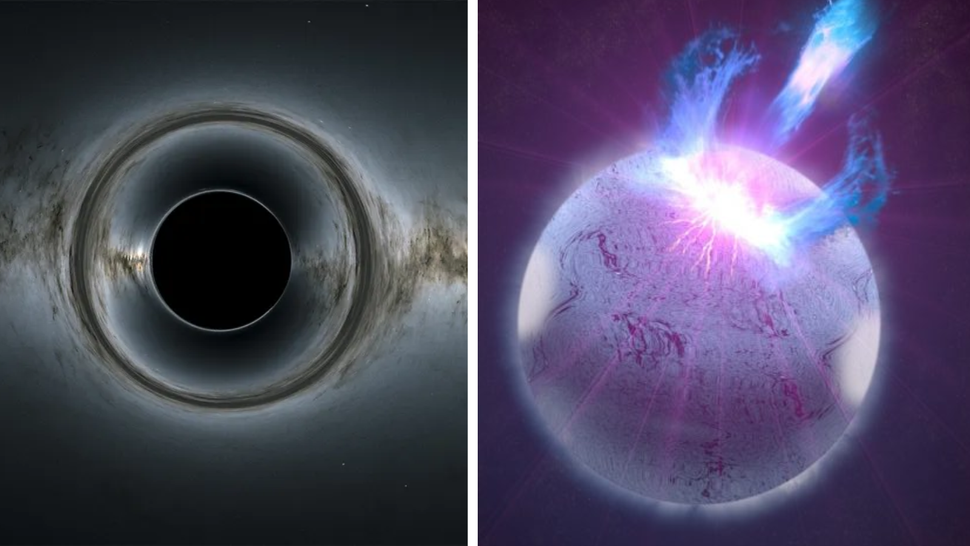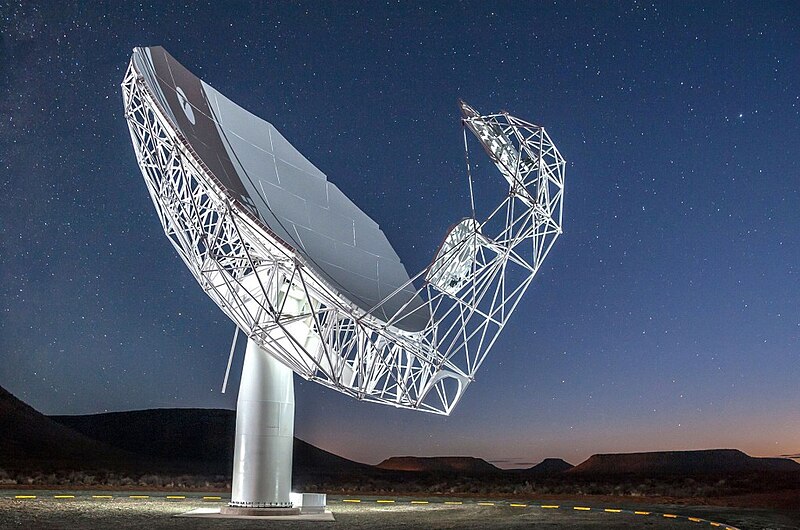Science
Related: About this forumNew mystery object could be lightest black hole ever seen
By Robert Lea published about 5 hours ago
"Uncovering the true nature of the companion will be a turning point in our understanding of neutron stars, black holes, and whatever else might be lurking in the black hole mass gap."

a dark black orb in space and a white star with purple clouds shooting out of it
Illustrations of a black hole (left) and magnetic fields erupting from the surface of a neutron star (right). (Image credit: NASA’s Goddard Space Flight Center/S. Wiessinger, ESA/Gaia/DPAC)
Astronomers have discovered a mystery object in the Milky Way that is more massive than the heaviest neutron star but lighter than the smallest black hole.
The mystery body could help scientists better determine where to draw the dividing line between neutron stars and black holes, both born when a massive star dies.
"Either possibility for the nature of the companion is exciting," team leader and University of Manchester professor of astrophysics Ben Stappers said in a statement. "A pulsar–black hole system will be an important target for testing theories of gravity, and a heavy neutron star will provide new insights into nuclear physics at very high densities."
The object was discovered using the , which is comprised of 64 antennas located in the Northern Cape of South Africa. The dense stellar remnant is orbiting a rapidly spinning neutron star or "millisecond pulsar" located around 40,000 light-years away within a dense clump of stars called a "globular cluster" in the Milky Way.
More:
https://www.space.com/mystery-object-lightest-black-hole-heaviest-neutron-star





Easterncedar
(3,522 posts)Sometimes I admire humans. Not often, but this…so cool. Thanks!
Hermit-The-Prog
(36,588 posts)Rumor is that neutron stars are yummy, if you can catch one.
Judi Lynn
(162,379 posts)Story by Nina Massey •
12h
A new and unknown object in the Milky Way that is heavier than the heaviest neutron stars known to scientists, and yet lighter than the lightest known black holes, has been discovered by astronomers.
Researchers from a number of institutions including The University of Manchester and the Max Planck Institute for Radio Astronomy in Germany found the object in orbit around a millisecond pulsar 40,000 light years away in a dense group of stars known as a globular cluster.
Millisecond pulsars are a type of pulsar (neutron star with pulses of radiation) that spin very rapidly – hundreds of times per second.
Either possibility for the nature of the companion is exciting
Ben Stappers, University of Manchester
According to experts, it could be the first discovery of a radio pulsar – black hole binary – a pairing that could allow new tests of Einstein’s general relativity and open doors to the study of black holes.
UK project lead Ben Stappers, Professor of Astrophysics at The University of Manchester, said: “Either possibility for the nature of the companion is exciting.
“A pulsar–black hole system will be an important target for testing theories of gravity and a heavy neutron star will provide new insights in nuclear physics at very high densities.”
More:
https://www.msn.com/en-us/news/technology/astronomers-discover-a-mysterious-object-in-the-milky-way/ar-AA1nbXC5
Judi Lynn
(162,379 posts)JANUARY 18, 2024
by University of Manchester

An artist’s impression of the system assuming that the massive companion star is a black hole. The brightest background star is its orbital companion, the radio pulsar PSR J0514-4002E. The two stars are separated by 8 million km and circle each other every seven days. Credit: Daniëlle Futselaar (artsource.nl)
An international team of astronomers have found a new and unknown object in the Milky Way that is heavier than the heaviest neutron stars known and yet simultaneously lighter than the lightest black holes known.
Using the MeerKAT Radio Telescope, astronomers from a number of institutions including The University of Manchester and the Max Planck Institute for Radio Astronomy in Germany found an object in orbit around a rapidly spinning millisecond pulsar located around 40,000 light years away in a dense group of stars known as a globular cluster.
Using the clock-like ticks from the millisecond pulsar they showed that the massive object lies in the so-called black hole mass gap.
It could be the first discovery of the much-coveted radio pulsar—black hole binary; a stellar pairing that could allow new tests of Einstein's general relativity and open doors to the study of black holes.
More:
https://phys.org/news/2024-01-lightest-black-hole-heaviest-neutron.html#google_vignette